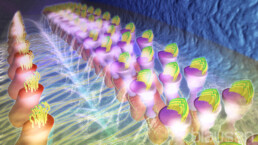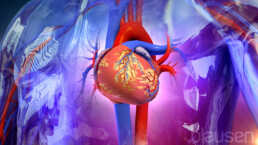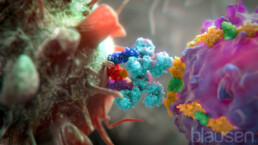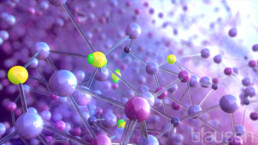The complexity of the human anatomy continues to pose a significant challenge for aspiring engineers, scientists and physicians. Whether they are preparing to treat patients, conduct research or develop new health care technologies, today’s students rely on modern, in-depth educational tools to master this difficult subject. Thanks to the vision and generosity of medical animation pioneer Bruce Blausen, Texas Engineering is now the sole custodian of one of the world’s most comprehensive and visual learning resources for students.
Founded by Blausen in 1991, the Blausen Medical Library has grown to become the largest collection of biomedical and scientific visual aids ever produced. With more than 28,000 3D animations and illustrations detailing everything from allergen vaccines to white blood cells, the library covers over 1,800 topics, including diseases, treatments and the human anatomy from muscles and organs down to the cellular and molecular levels. In May, Blausen gave the entire library to the Cockrell School, making the vast archive of medical images freely available to aid in the education of every student on campus.
“In my initial conversations with faculty and staff at UT, I could immediately sense their excitement as they envisioned potential applications in labs and classrooms,” Blausen said. “I knew then that if I made the full library permanently available, its impact could be immense. It could serve an important purpose for students’ technical development.”
Faculty members throughout the Cockrell School have already identified courses in which students will benefit from access to the library—from tissue physiology classes that prepare mechanical engineers to develop rehabilitative technologies to drug delivery classes that aid biomedical engineers in the fight against cancer.
“Biomedical engineering requires a comprehensive, interdisciplinary knowledge not only of the technologies we use to treat health-related issues but also of the biological conditions underlying those issues,” said Shelly Sakiyama-Elbert, chair of the Cockrell School’s Department of Biomedical Engineering. “The Blausen Library will help us provide students with the well-rounded education they need to embark on successful careers.”
As the formal recipient and host of this extensive database of image and video files, the Cockrell School will also provide access to fellow colleges, schools and units across the Forty Acres.
“The Blausen Library is unlike any other in the world, and we are so happy to be able to extend the benefits of this extraordinary resource to the entire UT Austin community,” said Sharon L. Wood, dean of the Cockrell School. “I believe that, in sharing this collection with each other, we will also open new channels of communication that help us further establish UT Austin as a global hub for health care delivery, education and research.”
In the coming years, advances in virtual reality technology are expected to further enhance the Blausen Library experience, offering opportunities for unprecedented immersion by placing students inside a “digital classroom” where they can watch animations on a large virtual screen or interact with 3D models. Blausen’s team is currently exploring the potential of this new learning environment, and Texas Engineers will be among the first to set foot in it.




